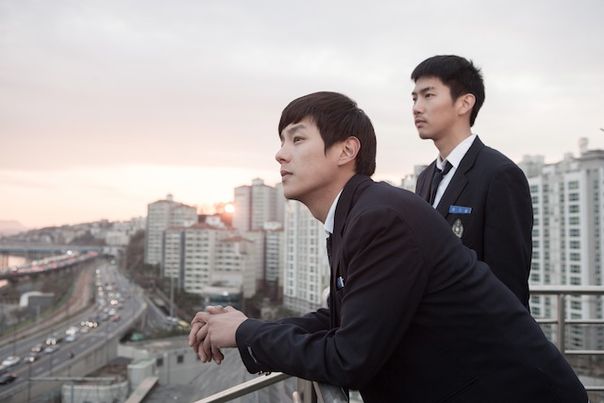Flying in the Face of Convention
Daria Lisitsina reviews Lee Song Hee-il’s virtuosic second feature NIGHT FLIGHT.

Lee Song Hee-il's NIGHT FLIGHT
Like thunder before lightning, we hear before we see and we see before our eyes focus. The opening shot: the sound of an oncoming train, a fuzzy image of a hill, into which a boy on a bike sharply emerges. In Lee Song Hee-il’s second feature NIGHT FLIGHT, an anatomically subtle study of the fraught relationship between two schoolboys weaving their way through the incarcerating Korean school system, the camera does virtuoso storytelling work, gently drawing the spectator into its world. Characters glide into still frames, blurred images slowly focus; an entire silent dialogue is conveyed through the shifting foregrounding from one boy to another. The film places great emphasis on looking: emotionally charged stolen fleeting looks, I-challenge-you stares, exchanges of unspoken and unspeakable understanding. We see the world not through the characters’ eyes, but in their very eyes. The actors’ gripping performances aptly use the human face as a canvas for portraying depth and ambiguity of feeling. But this is as much a testimony to the cinematography, which eschews more conventional static close-ups in favour of agile 360° degree portraits. The camera dances around the human face, taking in atmospheric background landscapes in the periphery of its gestures. Much of the film takes place outside of the space of the main city: under train bridges, in scrapyards, in fields. The foregrounding technique used throughout establishes a marked distance between the two protagonists and the city (and by extension society) they are victims of.
NIGHT FLIGHT, running in Berlinale Forum, is epic in scope, looking at cultural homophobia and the detrimental effects of a highly competitive, pressured education system through the prism of internal emotional drama. It has the linear ebbing rise and fall narrative rhythm of a classical tragedy. This dynamic is literalised in the form of the boys racing up and down the city's hilly terrain – away from bullies and towards loved ones. Although the film invites a contemplative viewing experience, the dominant current pulsing through Hee-il's neon-lit Seoul is urgency and brute force: the kind of urgency of feeling that is particular to adolescence; the unprecedented force of displaced emotion that comes out in an outburst of uninhibited, undistinguishing physical aggression. The title NIGHT FLIGHT refers, none too subtly, to an abandoned gay bar at the top of a Seoul skyrise, where the protagonist escapes to from the unaccepting, stone-cold face of society. But NIGHT FLIGHT is anything but a flight and the film's initial fantasy of running away is replaced with the possibility of escaping in someone else's arms. Like its ending, the film itself is an act of defiance in a society where there is great social pressure to stay in the closet.

